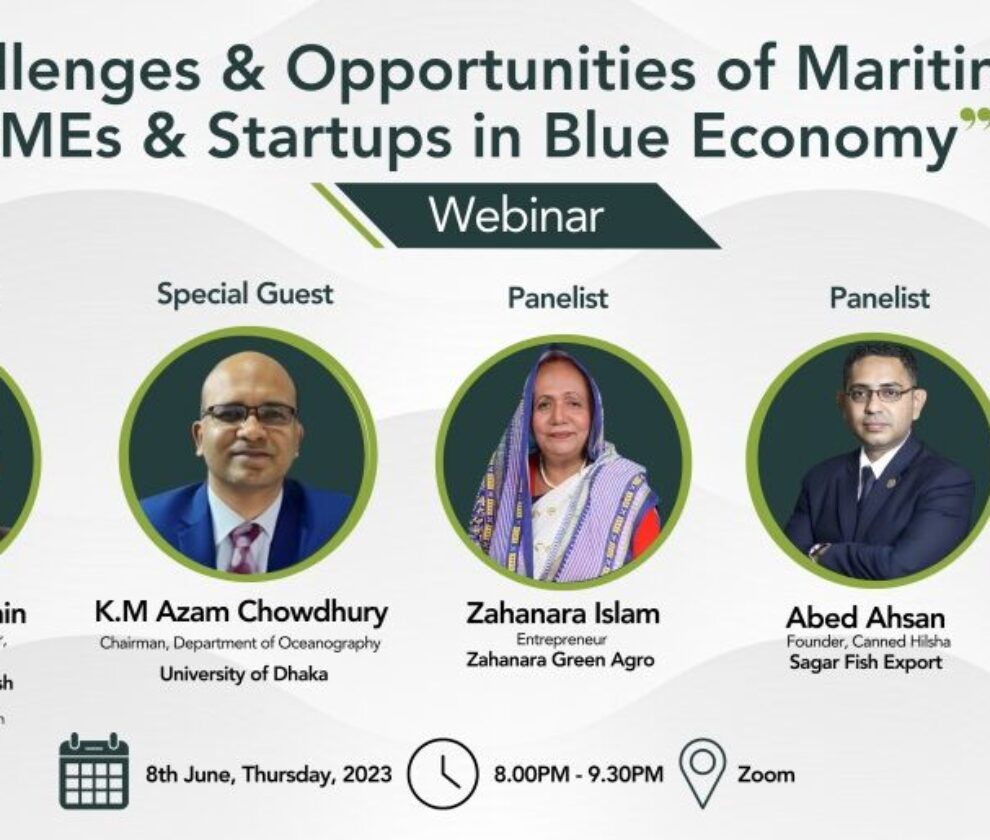Background:
The study is conducted to analyze the overall halal food sector and its potential in the domestic and global market. The report focuses on halal food and the certification processes in Bangladesh, along with a breakdown of the business scenario of meat, poultry, and fish industries of the country. The report also reflects on the domestic conditions of other sub sectors and discusses the halal aspects of those sectors.
The broader objective of this study is to understand the current situation of Halal market in Bangladesh and study the potential of export of Halal food products from Bangladesh.
The specific objectives of this study are given below:
- Analyzing the Domestic Market
- Market size of halal food industry in Bangladesh – past 10-year history and future 10-year projection
- Main players – their history, sales volume, main products, strength/weakness, etc.
- Market share – customer & product industry wise market share analysis in percentage (%)
- Analyzing export and import scenario of Halal food products in Bangladesh.
- Analyzing the regulations for import and export of Halal food
- Formulating halal product marketing strategies
Halal Food: Context, Landscape, Prospects, and Challenges
Global Halal Food Landscape
The global Muslim expenditure on halal food reached $1.27 trillion in 2021 and is projected to hit $1.67 trillion by 2025. Leading countries in halal food spending are Indonesia, Bangladesh, and Egypt.
Capitalizing on this trend, global companies are entering the halal food market through acquisitions:
- Germany’s Gelita AG obtained 65% of a joint venture with Turkish halal-certified gelatin producer SelJe.
- UK’s Halaloodies experienced a 30% online sales increase due to the popularity of its precooked and pre-flavored meats and protein.
- Malaysia’s Kawan Foods doubled net profit in 2020 with a focus on ready-to-eat meals, healthy plant-based products, and alternative proteins.
- Brunei-UAE joint venture Saahtain is introducing plant-based ready-to-eat meals and exporting to Sweden, capitalizing on demand.
Meat and Poultry
The meat and poultry sector of Bangladesh includes around 43 crores animals. Despite this huge number of animals, the protein deficiency persists. The livestock industry is one of the fastest growing industries in Bangladesh, contributing around 2% to the country’s GDP and more than 16% to the agricultural sector in FY 2021-22.
Bangladesh has the production of 131 (130.74) lakh metric tons of milk, about 93 (92.65) lakh metric tons of meat, and more than 2335 million eggs in FY 2021-22. Besides, from FY 2017-18 to FY 2020-21, it was possible to meet the demand for sacrificial animals during Eid-ul-Azha only through domestically produced cattle.
As for notable market players, several agro-farms like Kazi Farms, Paragon, Purnava, and Omega have sprung up in the past few years and they are selling branded eggs on the domestic market. But Bangladesh doesn’t have any particular brand for processed meat. However, there are some super shops like Bengal meat, Protein Market, Royal Meat, Shwapno, Agora, and Unimart, that sell prepared poultry and meat through their physical stores and online shops. Apart from these, agro-businesses like CP and Kazi Firms are also selling ready-to-eat and ready-to-cook meat.
Ruminant Meat
Halal Certificate: Highly Required
The ruminant meat market in Bangladesh is driven by a steadily increasing population of livestock and increasing opportunities for livestock rearing in the country. The population of livestock (Bovine and Equine) in Bangladesh is expected to number at 58.72 million by 2026, up from 57.13 million in 2022, at a relatively consistent average annual growth rate of 0.70%.
Since most of the market is driven by local butchers, safety concerns are estimated to be not adequately addressed. The only large companies conducting business in the beef value chain are currently Bengal Meat, Protein Market, and Sadeeq Agro. Other companies like Titas Food and Agro have some reach in animal rearing and the processed beef category, but the market is primarily dominated by small farms and local vendors.
93% of the beef sale in Bangladesh is done through traditional channels (local butcher shops) and the other 7% is done through supermarkets, online shops. At present, only a few companies such as Bengal Meat and Protein Market are selling beef through modern channels. In Bangladesh, revenue in the Fresh Meat segment is projected to be US$14.52bn in 2023. The market is expected to grow annually by 11.20% (CAGR 2023-2027)
Challenges in the Meat Market
- Higher price of Cattle Feed
The price of all animal products has been rising since January 2022. Volatile crop markets, interruption in global supply chain, soaring freight costs, and increased dollar price were the reasons behind the hikes. Smaller size of Bangladeshi buffalo production prevents it from securing economies of scale regarding feed purchases.
- Absence of proper veterinary care
There are 8,025 veterinarians in Bangladesh. Interestingly, the current veterinary medicine market in Bangladesh is Tk3,000 crore with an annual growth of 8%-12% – raising the question who is actually prescribing the medicines? There are several illegal practices in place in the veterinary industry where many unregistered vets are creating confusion in the industry. The indiscriminate use of medicines, particularly antibiotics, by local quacks and pharmacists to treat cattle diseases poses a risk to public health.
- No zoning for animal rearing and testing
According to Islamic Foundation, Bangladesh meat processors and sellers are not receiving certifications from several countries such as Saudi Arabia because the country does not have specific zones to prevent contamination and spread of diseases. Due to a lack of proper testing facilities, Bangladeshi meat production companies face difficulties in acquiring certification from foreign markets regarding exporting meat-based products.
- Shrinking Farmland
Approximately over 69,000 hectares of agricultural land have been shrinking annually due to rapid industrialization, unplanned urbanization and increase in rural settlement.
- The cycle of price increase and losses
Due to the increase in feed cost, medicine cost, and cattle rearing costs, the price of the end product has also increased in both domestic and international markets. Which in turn increases the competition of Bangladeshi meat in the international market.
Poultry
Halal Certificate: Highly Required
Bangladesh produces a total of 1.48 crore day old cheeks on a weekly basis. The total poultry market can be broken down into three subcategories in terms of poultry variety:
- Broilers make up over 58.5% of the total market, with 53,000 broiler farms all over Bangladesh.
- Sonali chicken makes up around 28% of the market.
- The rest is occupied by laying chicks.
Kazi Farms, AG foods, CP, Nourish, Paragon, Aftab G.P. Ltd., and Quality are leading participants in Bangladesh’s poultry business.
The average global price of poultry is $ 5.25. In contrast, the average price of poultry in Bangladesh has been around $ 2.8 in March 2023.
The import market of poultry is worth $ 19.4 million, with countries like Malaysia, the UK, France, and Netherlands being dominant market players.
Some recent, important trends within the poultry industry are given below:
- Since November 2022, Bangladeshi farmers have been selling Broiler chicken at losses upto 20 BDT/KG. During this time, production cost of Chicken was BDT 135/KG, while wholesale price was around BDT 115/KG
- At present, farmers are incurring losses of BDT 1 per chicken sold.
- Due to sustained losses, many small poultry farmers have been compelled to cease operations.
- The Directorate of National Consumer Rights Protection estimates that the number of poultry farmers ceasing operations within this time amounts to around 63,000 (40% of registered poultry farms)
- Around 158,000 farms were operational in November, only 95,000 of which are active now.
- The authorities suspect that larger corporations such as CP and Kazi, who occupy only 10% of the total market, are shortening the poultry market to drive out small scale operations.
- This is owing to the severe fluctuations in chicken and egg prices recently in Bangladesh. 4 large corporations stated that they would sell chicken at BDT 190-195 on 24th March. As of 2nd April, they are selling chicken for BDT 150-155
- Chicken prices reached BDT 270 before this during March 2023. Experts believe that this manner of price fluctuation cannot be naturally caused, and market influencing is being conducted by larger corporations.
Challenges in the Poultry Market
- Disease Outbreaks:
Avian influenza (Bird Flu) infected numerous hens in the nation in 2007, 2009, 2011, and 2017.
Bangladesh incurred a loss of around BDT 5,500 crore and approximately half of the country’s farms lost business.
- Import Dependent Vaccination:
Most vaccinations meant to prevent bird-flu are import-dependent. This makes vaccination costly and time-consuming.
- Lack of Adequate testing laboratories:
Bangladesh still has only one testing lab, which has emerged as a challenge for this industry.
- High price of feed and import challenge:
Seasonal crops such as soybeans, maize, palm oil, and rice husk are frequently imported from India, China, and South America. In 2019, 36% of the country’s soybeans had to be imported, as did 50- 60% of the country’s maize. Reliance on imports limits the production of regular feed production.
- High competition with foreign companies:
According to a BPICC source, foreign firms dominate 40% of Bangladesh’s poultry sector, with seven foreign corporations controlling the majority of it. Such businesses may often function with cheap interest loans (2-3%) from abroad, but local businesses must borrow at a higher interest rate from banks (10-12%).
For Domestic Market: similar to the Ruminant meat market, the poultry market is also very unstructured and raw chicken or chicken meat is not regularly in supermarkets under brand names. But there is an opportunity of expansion through products like frozen whole chicken, pre-diced chickens, processed and further processed chickens. During the pandemic, the demand for RTC and RTE increased significantly. Potential Partners include AG foods, Kazi foods, Golden Harvest, F-commerce businesses selling green chickens.
For Export: Bangladesh is under the Bird Flu zone now, and export of chicken is banned from the government. But, as soon as bird flu is not prevalent in Bangladesh, companies can start exporting frozen chickens along with frozen chicken products for RTC and RTE segments. This can be a scope of investment.
Fish: Live, Chilled and Processed
Halal Certificate: Medium to Low Requirement
Fish is Bangladesh’s primary export food product, and the nation regularly produces a large amount of fish surplus to local demand. Bangladesh acquired 2nd position in open water fish harvesting, 3rd position in inland open water fish harvesting, and 5th in cultured fish production. Bangladesh is ranked as number 1 within the list of 11 Hilsa producing countries worldwide. The country produced over 4.86 million (48.52 lakh) tonnes of fish during the fiscal year 2021-22. Using historical data, it can be projected that Bangladesh will produce 5.3 million (52.98 lakh) tonnes of fish during fiscal year 2024-25.
Freshwater Fish: 1.37 million Tons in 2021-22.
Marine Fish: 697,338 Tons in 2021-22. Projected to grow to 736,718 tonnes in 2024-25
Shrimp is one of the most significant fish products in Bangladesh, both in terms of production capacity and export volume. Bangladesh produced 251964 metric tons of shrimp in 2020-21. This is projected to grow to 260607 metric tons in 2024-25. Overall shrimp production is projected to grow at a CAGR of .68% until 2024-25. The shrimp industry has been given special preference under Export Policy Order 2021-24 – with incentives and cash assistance for training, infrastructural development, and quality improvement.
Exports: Exporters fetched $532 million by shipping frozen fish abroad in fiscal 2021-22, posting growth of 12 per cent year-on-year from $477 million previously, showed data from the Export Promotion Bureau (EPB).
Export Barriers: Fish from Bangladesh is not permitted to be exported to Saudi Arabia from 2019. Saudi Arabian authorities found pig extracts in fish imported from Bangladesh during texting. This extract might be derived from fish food. According to the respondent, fish feed also contains tannery leather and shutki of smaller fish. This source’s pork fat may have played a role in the tragedy.
Also, due to the discovery of potentially harmful germs in some export consignments, Qatar has temporarily banned the import of seafood from Bangladesh. Respondents noted that a variety of seafood, such as fish, shrimp, squid, mussels, oysters, etc., were included in the import ban. Before the FIFA Football World Cup 2022, the Qatari government launched a local quality audit, which led to the decision.
Frozen, Processed and Further Processed Food
Halal certificate: Highly Required
The frozen food sector of Bangladesh is growing at 7.1% and can be divided into two sub-sectors: Ready to eat and Ready to Cook. Following are some of the more important reasons for this growth:
- Fast-paced urban life,
- rising disposable incomes,
- an increase in the number of women in the workforce, and
- a preference for nuclear families
Kazi, Golden Harvest, AG Food, Pran, and McCain are some of the major players in this sector. Following is a comprehensive segmentation of the frozen food market of Bangladesh.
Challenges in the Frozen, Processed and Further Processed Food
- Market Access and Compliance:
Tariff and non-tariff barriers, along with procedural obstacles, hinder frozen food exports. Compliance with stringent SPS standards, especially in high-end markets, like the EU and the US, remains challenging.
- Transport and Infrastructure:
High transport costs due to road congestion and delays impact business operations. Limited access to electricity and cold storage facilities hampers sustainable agro-industrial development.
- Quality and Packaging:
Excessive pesticide use and post-harvest damage affect product quality. Varying packaging requirements from buyers pose packaging challenges.
- Access to Finance:
Limited access to finance, particularly for SMEs, affects supply and export capabilities. Bureaucratic obstacles in accessing cash incentives provided by the government impact export-oriented SMEs.
- Institutional Inefficiencies:
Agencies like Bangladesh Customs, BSTI, and others suffer from institutional inefficiency. Limited human resources, testing labs, and infrastructure impede compliance with international standards.
Halal Certification | Bangladesh and International
Demand of Halal Certificate
The demand for halal certificates has been increasing in the international market gradually. Over the past 10 years, halal certified products and services have been in high demand and are upward trending. According to the State of the Global Islamic Economy Report 2018/19 by Thomson Reuters, the halal industry, a $2.4 trillion dollar industry, is expected to surpass $3 Trillion dollars by 2023.Global halal food market is valued at USD 1,977 billion in 2021, and it is expected to attain a value of USD 3,907.8 billion by 2028, at a CAGR of 11.25% over the forecast period (2022-2028). This growth of the halal food market will be aided by several factors,
- including rising incomes,
- increased preference for healthier diets, and
- increased awareness of halal foods among consumers.
A comparison between BSTI and Islamic Foundation
The process of getting halal certified is the same for both organizations, only cost and accreditation differences between them exist.
BSTI | Islamic Foundation |
|
|
Relevant Marketing Strategies of the Halal Food Industry
This section highlights marketing strategies for businesses entering the halal food industry. Descriptions of the marketing strategies are given in the following:
Zoning Alignment
According to Bangladesh Export Processing Zone Authority (BEZA), there are 68 Government Approved economic zone sites, in addition to 29 Private zone sites. These zones are meant to encourage rapid economic development through diversification of industries and augmentation of employment, production, and export. Agro-processing, cold chain and export processing products are some of the preferred sectors for investment in the Economic zones, some of which are already in operation with significant investments from foreign companies
Halal Branding
Several studies have found a positive correlation between Halal Branding and consumer perception which in turn influences larger sales volumes and increases brand satisfaction and loyalty. In a 2021 study, t-test results showed that for the marketing strategy variable, the t value is 2.621 and the sig value is 0.011 which means it is smaller than the 0.05 probability. This shows that the effect of marketing strategies on the level of consumer confidence has positive results & contextualizing Halal branding and translating it into strategies for a market actor in Bangladesh should ideally focus on how local consumers perceive the Halal tag.
Halal e-commerce/website marketplace
The Bangladesh e-commerce market size in 2021 was Tk 568.70 billion and will be around Tk 1.5 trillion by 2026, growing by 17.61% annually. A larger population of consumers conduct transactions online, and online presence has become necessary for most products. There aren’t any significant e-commerce platforms dedicated to selling Halal products to consumers or businesses in Bangladesh yet. Khaas Food and Hamdard have a limited online presence. This is a strategic opportunity that Investors can explore by establishing a robust e-commerce platform for Halal agricultural products, which can be expanded to include other halal products.
Repackaging and Distribution through Private Labeling
Private labeling is an interesting prospect, and often executed by large brands. E.g., Costco and Kirkland in the United States. Certain Key-informants in our study have stated that it is possible for them to export products under the brand of other companies by acting as suppliers. Hence, It may be possible to export products to foreign markets through similar Private Labeling strategies by working with third party organizations.
Triangulating Halal products with Healthy and Sustainable Tags
Several Key stakeholders exporting to Bangladeshi Diaspora inform that Halal products are gaining popularity in other populations as well, due to a healthy and sustainable perception of Halal production methods. Halal certification is a critical component of this line of strategy, as it adds a point of scrutiny that plays a part in convincing consumers to purchase, especially other consumers not very familiar with Halal producers.




